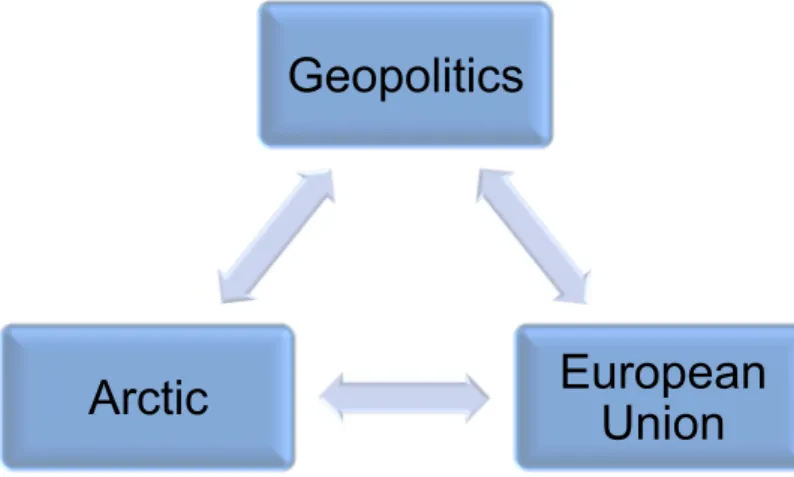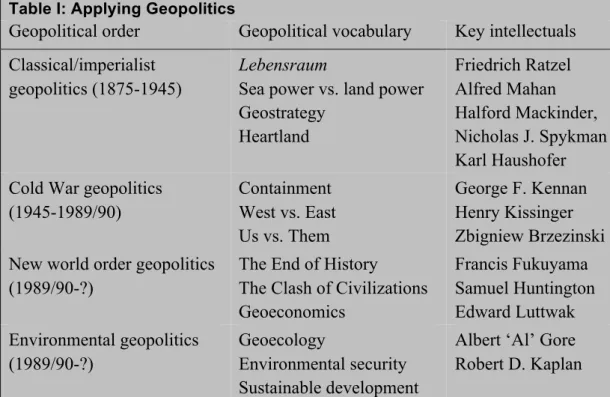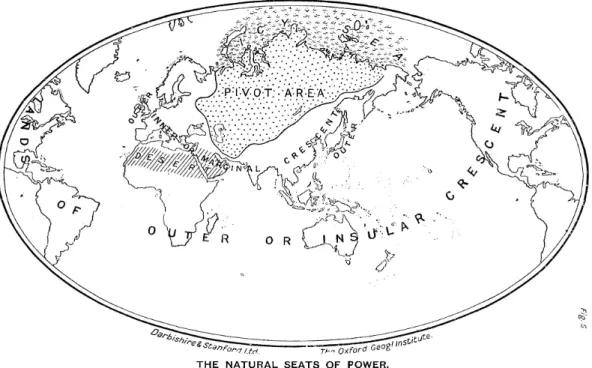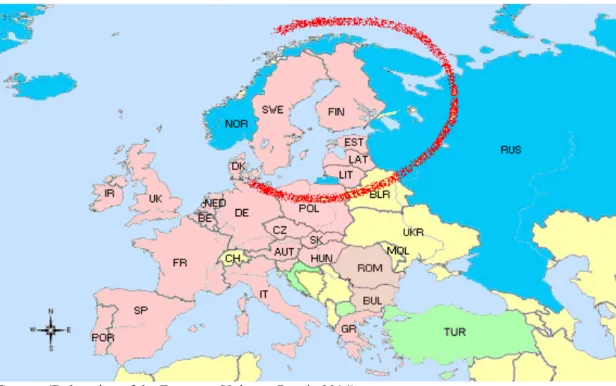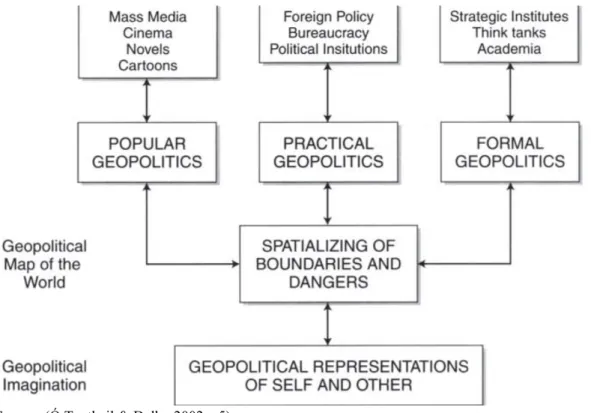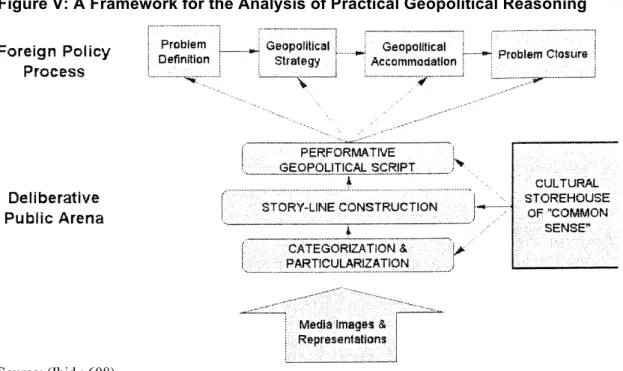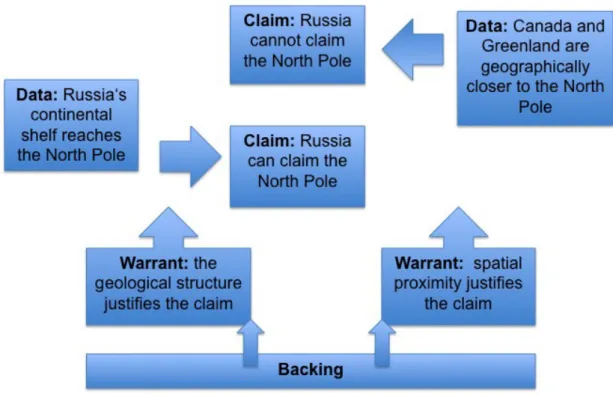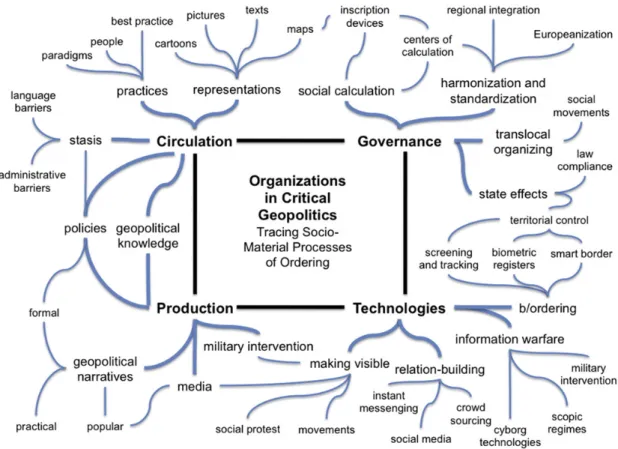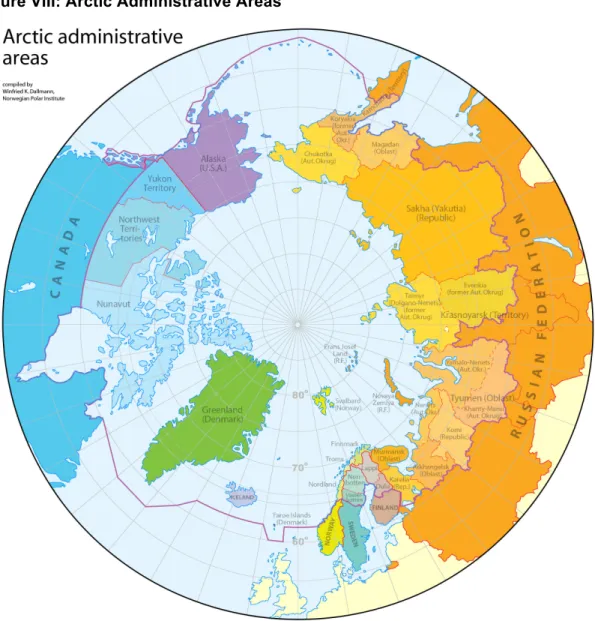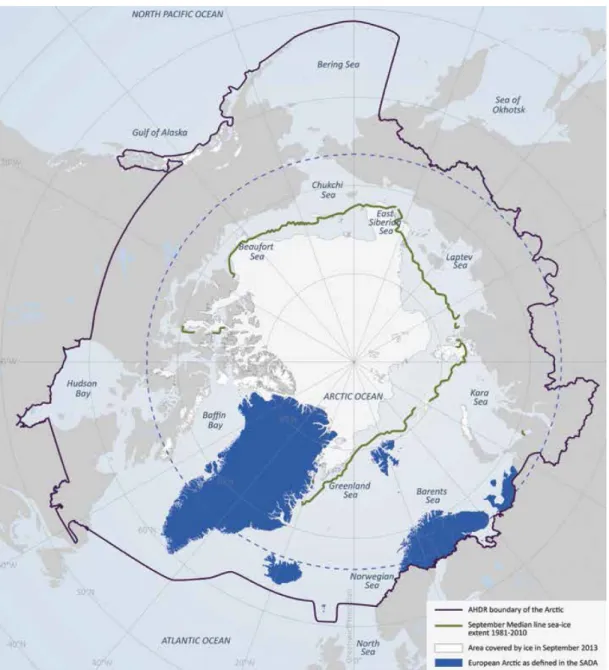ANDREAS RASPOTNIK
The European Union and its Northern Frontier
EUropean Geopolitics and its Arctic Context
The European Union and its Northern Frontier:
EUropean Geopolitics and its Arctic Context
Inauguraldissertation zur
Erlangung des Doktorgrades der
Wirtschafts- und Sozialwissenschaftlichen Fakultät der
Universität zu Köln
2016
vorgelegt von
Mag. Andreas Raspotnik, LL.M.
aus
Finkenstein, Österreich
Referent: Prof. Dr. Wolfgang Wessels (University of Cologne)
Korreferent: Prof. Dr. Lassi Heininen (University of Lapland, Rovaniemi)
Tag der Promotion: 12 Oktober 2016
TABLE
OFCONTENTS
PREFACE ... III ABSTRACT ... VI ABBREVIATIONS ... VII LIST of FIGURES ... IX LIST of TABLES ... X LIST of TEXT BOXES ... X
PART ONE SETTING UP THE STUDY ... 1
1. Introduction: The Geopolitics of an Arctic Meltdown ... 3
1.1. The Academic Endeavour and the Dissertation’s Objectives ... 6
1.2. The Dissertation’s Line of Action: The Research Question and a Step- by-Step Approach ... 9
1.3. Value and Limitations: A Scientific Justification ... 16
1.4. The Roadmap: Geopolitics, the Arctic and the European Union ... 23
PART TWO UNDERSTANDING THE CONCEPT ... 27
2. The Thought Experiment Referred to as Geopolitics: A Classic, a Critical and a EUropean Approach ... 29
2.1. A Short Journey through Time: From Classic… ... 31
2.2. … to Critical Geopolitics: A Concept through Ages ... 40
2.3. EUropean Geopolitics or the Making-of a Geopolitical Subject ... 45
2.4. The Remains of Geopolitics: A Summary ... 55
3. A Longer Note on Methodology ... 59
3.1. Discourse Analysis and Critical Geopolitics ... 60
3.1.1. Texts as Key… ... 62
3.1.2. … and the Element of Spatial Argumentation ... 70
3.2. Organisations from a Critical Geopolitical Perspective ... 72
3.2.1. Looking at the Inside of an Organisation ... 73
3.3. Interviews and Data Collection ... 77
PART THREE UNDERSTANDING THE ARCTIC CONTEXT ... 79
4. Arctic Geopolitics and the Zeitgeist of the 21st Century ... 81
4.1. A Region under Close ‘Spatial’ Scrutiny ... 83
4.2. The History and Identity of a ‘Geopolitical’ Arctic ... 90
4.3. Arctic Rights: Black or White Hole? ... 100
4.3.1. Law and Governance in the Arctic: The Legal Situation ... 101
4.3.2. Law and Governance in the Arctic: The Institutional Approach ... 112
4.3.3. The Arctic Rights Round-Up ... 119
4.4. Arctic Interests: The Last Frontier? ... 123
4.4.1. A Flag beneath an Ocean of Melting Ice ... 124
4.4.2. Arctic Resources: An ‘Oil Dorado’? ... 132
4.4.3. Arctic Maritime Transportation: Putting Ships in Place? ... 141
4.4.5. And as for the Future? ... 152
4.5. Arctic Responsibilities: Adapting to a Changing Arctic ... 154
4.6. The Geopolitical Arctic of the 21st Century: The Bottom Line is that… ... 157
PART FOUR UNDERSTANDING THE CONTENT ... 161
5. EUropean Dimensions of Arctic Presence ... 163
5.1. Territorial Component and Legal Competences ... 164
5.2. Economic Interests and Demands ... 176
5.3. Environmental Footprint and Polar Research ... 182
5.4. Regional and Cohesion Policy ... 184
5.5. Four Broad Dimensions, one Brief Conclusion ... 188
6. An Action in the Making: The EU’s 21st Century Arctic Policy- Making Process ... 191
6.1. From the Cold War Era to 2007/2008… ... 192
6.2. … And from 2008 Onwards ... 198
6.2.1. Climate Change and International Security (High Representative & European Commission, 2008) ... 199
6.2.2. Arctic Governance (European Parliament, 2008) ... 201
6.2.3. The European Union and the Arctic Region (European Commission, 2008) ... 204
6.2.4. Conclusions on Arctic Issues (Council of the European Union, 2009) ... 211
6.2.5. Resolution on a Sustainable EU Policy for the High North (European Parliament, 2011) ... 213
6.2.6. Developing a European Union Policy towards the Arctic Region (European Commission & High Representative, 2012) ... 216
6.2.7. EU Strategy for the Arctic (European Parliament, 2014) ... 220
6.2.8. Developing a European Union Policy towards the Arctic (Council of the European Union, 2014) ... 222
6.3. In a ‘Policy-Making’ Nutshell ... 227
7. The EU’s Arctic Space-Making Practices ... 233
7.1. Geopolitical Ideas and the Union’s Moral (Arctic) Language ... 234
7.2. The Production of the EU’s Arctic Storyline ... 244
7.3. ‘Arctic Governance’ at a Distance ... 262
7.4. ‘Frozen’ Technologies of Geopolitical Ordering ... 269
7.5. A EUropean Geopolitical Subject in the Arctic? ... 273
PART FIVE AND THE BOTTOM LINE IS? ... 281
8. The Conclusion: The Triangle of Concept, Context and Content . 283 8.1. Research Results and Contribution ... 284
8.2. Future Research ... 296
REFERENCES ... 298
APPENDIX ... 352
PREFACE
Working on a dissertation seems like an endless process. It is a Sisyphean task that drives one to experience pure desperation creating thereby a steady state of self- consciousness and unrest – it simply and continuously but ever so effectively preys on one’s mind. Moreover, this process bears many obstacles, either of individual, administrative, financial or academic nature.
In March 2015, the English rock band Muse released their song Dead Inside.
Its lyrics, and particularly a short segment thereof, perfectly encapsulates the ‘normal state of mind’ and close relationship I have developed with the present study over the years – I gave you everything, I can’t give you anymore. Looking back at this long process of almost five years, I realise that I am indebted to so many sources of inspiration as well as diversified, indispensable support.
First of all, I am most grateful to four friends that have read and commented on substantial parts of my dissertation and whose humour, traits of character, expertise and personality helped me to survive this piece of lunacy unscathed: Wulf Reiners, Adam Stępień, Stefan Steinicke and Andreas Østhagen. I owe you guys.
The present study would also not be the same without the helpful discussions and/or feedback by Alyson Bailes, Klaus Dodds, Erik van Doorn, Nadezhda Filimonova, Piotr Gracyzk, Sebastian Knecht, Merje Kuus, Nengye Liu, Ingrid Medby, Martin Müller, Erik Molenaar and Scott Stephenson. Moreover, I would like to thank my two supervisors Wolfgang Wessels and Pontus Odmalm, who provided me the opportunity to obtain my doctorate and gave me the necessary scientific freedom to write the dissertation my way.
Aside from these people a wide range of friends and colleagues has joined me on this five-year long voyage. People I have either met in one of the many places I lived and worked in, or folks that have just always been part of my life.
My time in Cologne and Edinburgh, 2011-2013, was essentially shaped by the
entire community of the The Marie Curie Initial Training Network EXACT, notably
Aline Bartenstein, Marlene Gottwald, Leonhard den Hertog, Miguel Haubrich Seco
and James Nyomakwa-Obimpeh. Yet, Cologne was so much more than only EXACT. The hometown of the fabulous 1. FC Köln is also the home of the Jean Monnet Chair of Prof. Wessels and all the people that worked there, in particular Nicole Ahler, Fulden Eskidelvan, Cyril Gläser, Andreas Hofmann, Claudia Hefftler, Oliver Höing, Tobias Kunstein, Alice Oeter, Katrin Schmermund, Mirja Schröder and Funda Tekin – colleagues that became friends. Eventually, Cologne would not have been the same without Leonie Völker and her outstandingly great personality.
Moreover, I am grateful to have met my Norwegian language-fellow, Tobias Gockel, and I remain deeply indebted to my relatives in Cologne and Solingen – the Middeldorf-Radtke-Sidorczuk combo. Yet, EXACT has also brought me back to Brussels, giving me the chance to meet Laura Boone, Marine Jacob, Mirte van den Berge and Laura Ventura.
From 2014 onwards, I had the good fortune to live, research and write in Oslo and Berkeley, respectively. Being twice a Guest Researcher at the Fridtjof Nansen Institute (FNI) in Oslo, funded by the E.ON Stipendienfonds, enabled me to surround myself with scholars interested in Arctic matters. Hence, I would therefore like to thank the entire FNI-crew for the fruitful and quiz-challenging time at Polhøgda, most notably Jan Dalsgaard Sørensen, Geir Hønneland, Tor Håkon Jackson Inderberg, Claes Lykke Ragner, Kabir Taneja and my ‘running-mate’ Svein Vigeland Rottem. Moreover, Oslo was and will always remain precious to me because it is the place of as beloved people as Kata Kvaran, Alice Bothwell, Armin Fleischer, Michaela Frank, Despina Gleitsmann, Betteke van Noort, Admiral Rune Stavnes, Paul Troost and Blake Wergeland.
And yet, it was my residence in the Bay Area that made a lasting impression on
me. This beautiful and mind-blowing, however, ambiguous region of old and new,
poor and rich, swept me off my feet in so many ways. Hence, I am deeply thankful to
the Berkeley-Cologne Fund, which sponsored my research stay as Visiting
Researcher at the Institute of European Studies (IES) at the University of California,
Berkeley and the respective people in charge: Brit Sperber, Jeroen Dewulf and Gia
White. Eventually, it was the group of people that surrounded me in Berkeley that
made these six months memorable ones: Ritu Argawal, Magdalena Cadena, Joel
Coito, Aikaterini Florou, Raphaël Gellert, Derek Brother O’Leary, Ratko Marinkovic, and above all Eleana Vaja. And of course Alex Lorton, who, candidly, fascinated me from the very first moment I saw her.
I further wish to thank my ‘Arctic family’, my colleagues and friends – old and new – from The Arctic Institute, particularly Tom Fries, Victoria Herrmann, Malte Humpert, Marc Jacobsen, Kathrin Keil and (again) Andreas Østhagen. We have already achieved so much and come so far that we will definitely not stop here and now. Moreover, my ‘Arctic family’ further includes Tsar Igor Shevchuk and Gosia Smieszek. Thanks for everything guys.
Last but definitely not least, my deep and honest gratitude goes to all my friends as well as my family back home in Austria and all over Europe. In particular, to Manuel Bergmann and Alexander Planasch, who regardless of my physical location proved to be true friends throughout the entire time; to Christoph Posautz; to Philip Salzmann and Iris Stöckl; to the ‘Hawaiian’ and one and only Stefanie Suppick; to Adam Madsen and Claudia Wittwer; to the German/Swiss crew around Ursina Ammann, Bastian Gruhne and Sebastian Knab; to Gerhard Schaunig and Michael Siter; to Thomas Künster, Roman Lesjak, Roland Ressmann and Andreas Witschnigg. And chiefly to Katrin Binder, who fortunately re-entered my life, supported my last academic steps by simply being herself and being there for me, truly rocking my world ever since then. And I would also like to thank Arnulf Lagler and his indispensable financial support during my (long) life as a student.
To my mum Sigrid Raspotnik, without whom all this would not have been possible in the first place. To the best brother there is: Thomas Raspotnik. To my dad Arnold Raspotnik, the intellectually stimulating and left-wing discussions we continue to have, and his wife Eva Maria Happe. To my step-sister Raphaela and her family.
Finally, a concluding thanks goes to myself. For eventually not going insane
and for finishing this seemingly never-ending process. For being – in the words of
College & Electric Youth – a real human being, and a real hero, back against the
wall and odds, with the strength of a will and a cause.
ABSTRACT
The present study explores EUropean geopolitical agency in a distinct spatio- temporal context: the Arctic region of the early 21
stcentury. Thus, it provides an in- depth analysis of the European Union’s process to construct EUropean legitimacy and credibility in its ‘Northern Neighbourhood’ between 2008 and 2014.
Embedded in a conceptual and methodological framework using critical geopolitics, this study assesses the strategic policy reasoning of the EU and the implicit geopolitical discourses that guide and determine a particular line of argumentation so as to claim a ‘legitimate’ role in the Arctic and accordingly construct a distinct ‘EUropean Arctic space’. In doing so, it establishes a clearer picture on the (narrated) regional interests of the EU and the related developed policy and concrete steps taken in order to get hold of these interests. Eventually, the analysis gets to the conceptual bottom of what exactly fashioned the EU with geopolitical agency in the circumpolar North.
As a complementary explanation, this study provides a thick description of the area under scrutiny – the Arctic region – in order to explicate the systemic context that conditioned the EU’s regional demeanour and action. Elucidated along the lines of Arctic history and identity, rights, interests and responsibility, it delineates the emergence of the Arctic as a region of and for geopolitics.
The findings indicate that the sui generis character of the Arctic as EUropean neighbourhood essentially determined the EU’s regional performance. It explicates that the Union’s ‘traditional’ geopolitical models of civilian or normative power got entangled in a fluid state of Arctic affairs: a distinct regional system, characterised by few strong state actors with pronounced national Arctic interests and identities, and an indefinite local context of environmental changes, economic uncertainties and social challenges.
This study applies critical geopolitics in a Political Science context and
essentially contributes to a broader understanding of EU foreign policy construction
and behaviour. Ultimately, it offers an interdisciplinary approach on how to analyse
EU external action by explicitly taking into account the internal and external social
processes that ultimately condition a certain EUropean foreign policy performance.
ABBREVIATIONS
A5 Arctic Five
A8 Arctic Eight
AC Arctic Council
AEPS Arctic Environmental Protection Strategy
ATS Antarctic Treaty System
BEAC Barents Euro-Arctic Council
BEAR Barents Euro-Arctic Region
bboe Billion barrels of oil equivalents
CARA Circum-Arctic Resource Appraisal
CFP Common Fisheries Policy of the European Union CLCS Commission on the Limits of the Continental Shelf
COP Conference of the Parties
CS Continental Shelf
DG Directorate-General
DG CLIMA Directorate-General for Climate Action
DG MARE Directorate-General for Maritime Affairs and Fisheries DG RELEX Directorate-General for External Relations
EEA European Economic Area
EEAS European External Action Service
EEC European Economic Community
EEZ Exclusive Economic Zone
EFTA European Free Trade Association
ENP European Neighbourhood Policy
EP European Parliament
ERA European Research Area
ERDF European Regional Development Fund
ESS European Security Strategy
ETC European Territorial Cooperation
EU European Union
EUAIC EU Arctic Information Centre
EUMSS European Union Maritime Security Strategy
FP5 Fifth Framework Programme for Research and Technological Development (1998-2002)
FP6 Sixth Framework Programme (2002-2006)
FP7 Seventh Framework Programme (2007-2013)
FPA Fisheries Partnership Agreement (EU – Greenland)
FPZ Fishery Protection Zone
GNSS Global navigation satellite systems
GPS Global Positioning System
HR High Representative of the Union for Foreign Affairs and Security Policy
ICC Inuit Circumpolar Conference
IMO International Maritime Organization
IMP Integrated Maritime Policy
IPCC Intergovernmental Panel on Climate Change
IPOs Indigenous peoples’ organisations
IR International Relations
LNG Liquefied natural gas
LOS Convention Law of the Sea Convention
MEP Member of the European Parliament
MFA Ministry of Foreign Affairs
NAFO Northwest Atlantic Fisheries Organization NASCO North Atlantic Salmon Conservation Organization
NC Nordic Council
NCM Nordic Council of Ministers
ND Northern Dimension
NEAFC North-East Atlantic Fisheries Commission
NEP Northeast Passage
NM Nautical Mile
NSR Northern Sea Route
NWP Northwest Passage
OCT Overseas Countries and Territories
PA Partnership Agreement (EU – Greenland)
POPs Persistent Organic Pollutants
RFMO Regional fisheries management organisations
SAO Senior Arctic Official
SWD Staff Working Document
TEU Treaty on European Union
TFEU Treaty on the Functioning of the European Union
TSR Transpolar Sea Route
UN United Nations
UNFCCC United Nations Framework Convention on Climate Change
USGS U.S. Geological Survey
USSR Union of Soviet Socialist Republics
U.S. United States
WTO World Trade Organization
LIST of FIGURES
FIGURE I:THE NEXUS OF CONCEPT,CONTEXT AND CONTENT
... 8
FIGURE II:MACKINDER’S PIVOT AREA
... 34
FIGURE III:NORTHERN DIMENSION
... 52
FIGURE IV:ACRITICAL THEORY OF GEOPOLITICS AS A SET OF REPRESENTATIONAL PRACTICES
... 64
FIGURE V:AFRAMEWORK FOR THE ANALYSIS OF PRACTICAL GEOPOLITICAL REASONING
... 66
FIGURE VI:ARGUMENTATION MODEL (THE NORTH POLE CASE) ... 71
FIGURE VII:STUDY MAP OF TRACING ORGANISATIONS AS SOCIO-MATERIAL PROCESSES OF ORDERING IN CRITICAL GEOPOLITICS
... 74
FIGURE VIII:ARCTIC ADMINISTRATIVE AREAS
... 84
FIGURE IX:THE EUROPEAN ARCTIC
... 86
FIGURE X:MAJOR ARCTIC SHIPPING ROUTES
... 89
FIGURE XI:AZIMUTHAL EQUIDISTANT MAP CENTRING THE PIVOT AREA
... 92
FIGURE XII:MARITIME ZONES UNDER THE LOSCONVENTION
... 103
FIGURE XIII:MARITIME JURISDICTION AND BOUNDARIES IN THE ARCTIC
... 110
FIGURE XIV:ARCTIC COOPERATION FRAMEWORKS
... 122
FIGURE XV:SEA ICE EXTENT,SEPTEMBER 2007 ... 127
FIGURE XVI:SEA ICE EXTENT,SEPTEMBER 1996 AND SEPTEMBER 2012 ... 129
FIGURE XVII:PIOMASARCTIC SEA ICE VOLUME,MONTHLY SEA ICE VOLUME FOR APRIL AND SEPTEMBER FROM 1979 TO 2014 ... 130
FIGURE XVIII:MAIN OIL AND GAS AREAS,MINING SITES AND SEA-ICE EXTENT IN THE ARCTIC
... 136
FIGURE XIX:LARGE MARINE ECOSYSTEMS –CATCH ABUNDANCE
... 149
FIGURE XX:EUNORTHERN PERIPHERY AND ARCTIC PROGRAMME 2014-2020 187 FIGURE XXI:EUROPEAN DIMENSIONS OF ARCTIC PRESENCE
... 189
FIGURE XXII:THE GRAMMAR OF EU/ARCTIC GEOPOLITICS
... 245
FIGURE XXIII:AEUROPEAN GEOPOLITICAL SUBJECT IN THE ARCTIC? ... 274
LIST of TABLES
TABLE I:APPLYING GEOPOLITICS
... 32
TABLE II:THE EU’S ARCTIC POLICY MILESTONES,2008-2014 ... 198 TABLE III:JOINT PAPER ON CLIMATE CHANGE AND INTERNATIONAL SECURITY(2008) ... 201 TABLE IV:RESOLUTION ON ARCTIC GOVERNANCE (2008) ... 204 TABLE V:COMMUNICATION ON THE EUROPEAN UNION AND THE ARCTIC REGION
(2008) ... 210 TABLE VI:CONCLUSIONS ON ARCTIC ISSUES (2009) ... 213 TABLE VII:RESOLUTION ON ASUSTAINABLE EUPOLICY FOR THE HIGH NORTH
(2011) ... 216 TABLE VIII:JOINT COMMUNICATION ON DEVELOPING A EUROPEAN UNION POLICY
TOWARDS THE ARCTIC REGION (2012) ... 220 TABLE IX:RESOLUTION ON A EUSTRATEGY FOR THE ARCTIC (2014) ... 222 TABLE X:CONCLUSIONS ON DEVELOPING A EUPOLICY TOWARDS THE ARCTIC
REGION (2014) ... 223 TABLE XI:THE EU’S GEOPOLITICAL IDEAS FOR THE ARCTIC REGION
... 237
TABLE XII:EMERGENT EUROPEAN ARCTIC STORYLINES... 260
LIST of TEXT BOXES
TEXT BOX I:TORN BETWEEN POLITICAL GEOGRAPHY AND INTERNATIONAL
RELATIONS? ... 44 TEXT BOX II:THE EU’S ACOBSERVER STATUS AND THE UNDERLYING ISSUE OF
ANIMAL WELFARE
... 117
TEXT BOX III:IN OR OUT?ICELAND AND THE EU ... 168 TEXT BOX IV:ONE VOICE OR MANY VOICES?THE EU, ITS MEMBER STATES ANDTHE ARCTIC
... 224
TEXT BOX V:WHAT TO DO WITH A RUNAWAY?THE EU’S APPROACH TOWARDSGREENLAND
... 252
“Geopolitics by Nobody”
1PART ONE
SETTING UP THE STUDY
1. Introduction: The Geopolitics of an Arctic Meltdown
During the summer of 2007, Greenland – the world’s largest island – saw a number of relatively unfamiliar visitors: politicians from the European Union (hereinafter
‘EU’ or ‘Union’) and its Member States. The President of the European Commission at that time, José Manuel Barroso visited Greenland end of June. The then Italian Prime Minister, Romano Prodi and the German Chancellor Angela Merkel experienced global warming and the melting of Greenland’s ice sheet first hand in July and August, respectively (Maxeiner 2007; SpiegelOnline 2007). After the issue of climate change rose to the top of the G8 Summit agenda in Bad Doberan/Heiligendamm (Germany) in June 2007, Greenland became the ‘Mecca of climate tourism’ (Harris 2007; Bomsdorf 2007).
2Later that summer, the broader circumpolar North – the Arctic region – hit global headlines with the blurry picture of a Russian titanium flag, planted more than 4,000 m beneath the North Pole at the bottom of the Arctic Ocean. Moreover, images of an ice-free Arctic Ocean ruled the airwaves in September 2007 as the Ocean’s sea ice extent reached a record low – 38% below average (Comiso et al. 2008: 6).
The region’s (sea) ice was disappearing; and with the melting of the North Polar ice cap the ‘solid state’ of the Arctic was called into question. And yet, it was not climate change per se that allegedly affected the stability of the region but the very correlation of melting ice with enhanced accessibility and related (economic) opportunities for regional and non-regional actors (Dittmer et al. 2011: 205). The Arctic re-appeared as a centre of world politics (Heininen & Southcott 2010: 2) with a globally applicable, ambiguous and yet immediately recognised buzzword portraying the region’s manifold state of change and its ambivalent physical condition: Geopolitics.
Beyond all doubt, the summery events of 2007 brought “international geopolitical attention” back to the Arctic (Powell 2008: 827). Since then, the region emerged “as a space of and for geopolitics” and became a distinct feature in circumpolar but also international politics (Dittmer et al. 2011: 202) (Italics in the
2 The German original of ‘mecca of climate tourism’ reads as follows: “Das Mekka der Klima-
original). The term ‘Arctic geopolitics’ grew in popularity as a fashionable catchphrase that broadly encapsulated the fluid state of Arctic affairs, covering a plethora of opposing assumptions on the region’s (immediate and long-term) future.
These postulations included but were not limited to predictions rooted in a series of historical Cold War legacies, questions on national sovereignty and regional hegemony or the economic significance of the region’s resources and its maritime opportunities that eventually lead to ‘Arctic trouble’. Contrary-minded, a shifting, opening Arctic space was perceived as an area of multilateral cooperation that promotes polar region-building; a common space of sovereign states, bound together by a shared history and mutual future challenges. The growing internationality of the Arctic as observed in the region’s integration in patterns of globalisation or the emerging regional interests of non-Arctic actors based on economic or environmental considerations have further contributed to the conceptual vagueness of the very meaning of Arctic geopolitics (Knecht & Keil 2013: 181–186). A term Chaturvedi defined as “a historically contingent, but on-going, political project of scripting, staging, and projection of the circumpolar northern polar region” (2005a: 724). And without the shadow of a scientific doubt, the Arctic region has been politically, economically and socially re-scripted, re-staged and re-projected over the last decade.
Up to now, these intricacies have considerable been explored by academia, with yet many unknowns still existing. One of these many Arctic unknowns and essentially one component of Arctic geopolitics is the politico-economic union of (still) 28 Member States, whose prominent representative visited Greenland back in 2007: the EU. Ever since 2007/2008, the EU has started showing interest in the region’s climate, environmental and social challenges, as well as its economic opportunities.
This study deals with the Union’s process of ‘constructing’ EUropean legitimacy and credibility in its Northern Neighbourhood – the Arctic region.
Accordingly, this dissertation does not only provide an in-depth analysis of the
Union’s multidimensional Arctic presence and its Arctic (foreign) policy reasoning
but essentially also gives an insight of how the EU has actively aimed to ‘spatialise’
the circumpolar North when creating its own regional script: a EU Arctic policy.
Furthermore, deconstructing the term ‘Arctic geopolitics’ and its entangled components helps to understand the historical and spatio-temporal context the Union’s current Arctic (policy) approach is embedded in. The examination at hand uses the concept of ‘critical geopolitics’ in order to understand how and in what different nuances the Arctic, its opportunities and challenges has been brought into the EU’s political orbit by narrating and creating the Arctic region as an envisaged space of EUropean interaction and exertion of influence.
3Thus, the dissertation gives new indication on the fragmented debate regarding
‘Arctic geopolitics’ in general and the EU’s regional involvement in specific.
Moreover, it sheds light on the EU-internal processes of both geopolitical ordering and the related relations between the various EUropean institutions, as well as on geopolitical knowledge-production in the hallways of EUropean power. In that regard, the dissertation scrutinises the Union’s geopolitical behaviour not only in a very specific, under-researched, geographical area, but essentially provides insight into the EU’s internal and external structure as a geopolitical subject in the making.
This introductory Chapter proceeds as follows: Subchapter 1.1 delves into the academic endeavour and the related dissertation’s objectives by specifying a threefold destination route. This is followed by Subchapter 1.2, which clarifies the dissertation’s line of action and further identifies the scientific and analytical modus operandi. Subsequently, Subchapter 1.3 gives an answer on the indispensable question of both the added value and limitations of the research approach. Chapter 1 eventually concludes with an outline of the dissertation (Subchapter 1.4).
3 Based on Moisio et al., this dissertation uses the spellings ‘EUropean’ and ‘EUrope’ to “signify the complex entanglements of Europe and the EU in contemporary political practices” by simultaneously
1.1. The Academic Endeavour and the Dissertation’s Objectives
In March/April 2008 Foreign Affairs published an essay that constituted the then predominant zeitgeist of international debate on the Arctic region. As introduced by the essay’s author: “The Arctic Ocean is melting, and it is melting fast. (…) Global warming has given birth to a new scramble for territory and resources among the five Arctic powers.” (Borgerson 2008: 63) The year 2008 saw the Arctic being denoted as a “strategic area” of “vital interest” and of “rapidly rising geopolitical and geoeconomic relevance” (Cohen, Szaszdi & Dolbow 2008). The 21
stcentury has hardly begun but the label ‘geopolitics’ already entered the northernmost part of the Earth. Global climate change served as the instigator of the region’s political, economic, environmental and social transformation, which “catapulted the Arctic into the centre of geopolitics” (Ebinger & Zambetakis 2009: 1215). The related revival of traditional power politics was assumed to “set off a vicious circle, jeopardising the wide-ranging collaboration put in place since the end of the Cold War” (Blunden 2009: 121). The Arctic was on the move with significant implications for international relations and ‘geopolitics’ became the common denominator to portray the region’s constituting alterations.
At the very same time, on 14 March 2008, the EU’s High Representative and the European Commission issued a joint policy document that followed the same train of thoughts:
“The rapid melting of the polar ice caps, in particular, the Arctic, is opening up new waterways and international trade routes. In addition, the increased accessibility of the enormous hydrocarbon resources in the Arctic region is changing the geo-strategic dynamics of the region with potential consequences for international stability and European security interests.” (2008: 8)
The Arctic seemed to have appeared on the Union’s ‘neighbourhood radar’. And it
emerged using classic geopolitical reasoning: the availability of resources in the
region, induced by global warming, alters interaction between (state) actors and
consequently changes this particular region’s political dynamics, with alleged
consequences for EUropean security.
It is this precise point of ‘Arctic’ time that sets the basis for the dissertation at hand.
This analysis aims to ‘unpack’ Arctic geopolitics from a particular angle, the EUropean one.
4It does not only scrutinise the overstretched and poorly conceptualised term ‘geopolitics’ in a specific regional context, but essentially gives a first indication on the very ‘geopolitical’ behaviour of an international actor that is typically not referred to as a ‘geopolitical actor’.
Hence, geopolitics serves as the conceptual connector between a region (= the Arctic) and a subject (= the EU).
5Moreover, the dissertation – as a monograph on this topic for the very first time in European Studies – examines a region where the EU’s traditionally perceived types of power, in particular the common market or its normative influence, are considerably weaker than compared to the Union’s Eastern and Southern neighbourhood – vicinities where the EU is normally able to emerge as a more dominant actor. In that regard, Kobza referred to the Arctic’s regional system as one “with strong actors [that play] well-defined roles, which puts the Union in an extraordinary handicapped position” (2015: 5).
6In order to approach the EU’s ambiguous nature as a geopolitical actor from a distinctive case’s perspective only, the main purpose of this dissertation is threefold and aims to holistically comprehend the three C’s of concept, context and content, see Figure I (page 8).
4 Political geographers commonly use the term ‘unpack’ to describe their work on the understanding and analysis of geographical assumptions in politics. Based on the dissertation’s practice of critical geopolitics, this study employs ‘unpacking’ according to the common linguistic usage of political geographers as a substitute for ‘understanding’.
5 In the course of years, the EU has achieved a lot of independent agency due to its supranational elements. However, especially its external action draws a different picture with varying competences, national/supranational interests and positions characterising agenda- and policy-making. Hence, within the study of (critical) geopolitics, Aalto (2002) argued to describe the EU as a ‘geopolitical subject’ instead of ‘agent’ or ‘actor’. Accordingly, the Union is perceived as an unfinished construction process, see also (Boedeltje & van Houtum 2011: 141).
6 The region’s ‘strong actors’, repeatedly labelled as ‘Arctic Eight’ (A8), are: Canada, the Kingdom of Denmark (in relation to Greenland and the Faroe Islands) (hereinafter ‘Denmark’), the Republic of Finland (‘Finland’), Iceland, the Kingdom of Norway (‘Norway’), the Russian Federation (‘Russia’),
1. Understand the Concept. From a conceptional and methodological point of view, it deals with a persistently neglected question in the realm of Political Science and European Studies: What is the very meaning of geopolitics and how can it be used and conceptualised in the context of the EU being or not being a geopolitical subject? Hence, the analysis offers to be a display copy for an epistemic, self-contained academic community to eventually step outside its predefined theoretical and methodological box and old-school assumptions.
2. Understand the Context. From an explorative point of view, it performs an in-depth, thick description of the Arctic’s 21
stcentury’s (re)- geopoliticisation in order to provide a comprehensive overview of the external conditions that have an effect on EU foreign policy performance in the Arctic.
3. Understand the Content. From an analytical point of view, it scrutinises the EU’s multidimensional Arctic presence, the composition of a distinct regional policy toolkit and the various geopolitical rationales for and visions of EUropean Arctic space that has so far caused the assembly of the Union’s policy approach for the Arctic.
Figure I: The Nexus of Concept, Context and Content
Source: Own compilation
Geopolitics
European
Union
Arctic
Although academically embedded in Political Science and European Studies, this dissertation builds on intellectual contributions established and developed by Political Geography, in particular the concept of critical geopolitics.
7Consequently, this interdisciplinary approach aims to broaden the academic perspective of political scientists on the external relations of the EU. Notably, it discusses EU geopolitical agency in a geographical area persistently neglected in EU-related academic discussions, both from a Political Science and a Political Geography perspective: the Arctic region. By applying critical geopolitics, this analysis investigates the related space-making practices of the Union and the interconnected internal production of geopolitical knowledge and representation, both having ramifications for a very specific regional EU foreign policy-making process. Resting upon the definition of Knecht & Keil, ‘space-making’ means a “narrative configuration of distinct
“articulations”” (2013: 180). Adapted to the EU-Arctic context, it refers to the above-mentioned objective of ‘constructing’ EUropean legitimacy and credibility in the Arctic region.
1.2. The Dissertation’s Line of Action: The Research Question and a Step-by-Step Approach
This dissertation aims to shed light on the process of developing a distinct EUropean space in the Arctic through the following main guiding research question:
How and under what conditions did the EU construct EUropean space in the Arctic between 2008 and 2014?
Accordingly, ‘space’ is not defined as physical space in a strict geographical sense – the geographical demarcation of a certain territory – but rather as socially produced space. Thus, in the present EUropean case, ‘space’ is understood as EUrope’s identity, presence and power that operates within a system of structures, processes and flows (Bachmann 2009, 2015: 685).
8Broadly speaking, EUropean space is
7 It is not a contradiction in terms to use the adjective ‘geopolitical’ although advocating for a critical examination of geopolitics but relates to several strands of geopolitics, inter alia a classic one and a critical one, see Chapter 2.
8 According to Bachmann (2009, 2015), ‘identity’ derives from the Union’s integration process and its
determined as “regulated spaces of interaction characterised by a commitment to the rule of law, multilateralism, institution-building, democracy and universal values”
(Bachmann 2009).
By answering this research question the dissertation seeks to understand on how the EU – an actor that is typically not perceived to be an Arctic one – aimed to establish its own ‘Arctic legitimacy’ or based on the preceding conception, construct
‘EUropean Arctic space’ between 2008 and 2014.
The research question thus implies the understanding of the EU’s constructed image of the Arctic as well as the EU means by which this construction takes place.
By posing this question the dissertation establishes a clearer picture on the (narrated) regional interests of the EU and the related developed policy and taken steps by its respective policymakers in order to get hold of these interests.
In order to attain the highlighted main objectives (Subchapter 1.1), this dissertation follows a three-step analysis. Extracting the structure of the dissertation along concept, context and content serves the purpose to define the focus and the scope of the study:
#1. ‘Unpack’ geopolitics and its EUropean subsidiary (= concept)
#2. ‘Unpack’ Arctic geopolitics of the 21
stcentury (= context)
#3. ‘Unpack’ the geopolitical reasoning in the EU’s Arctic policy toolkit (=
content)
#1: Understanding the Concept
•
The ambiguity of ‘geopolitics’ and its critical spin-off
•
The nature of its emerging EUropean branch
The dissertation’s first step elaborates on the complexity and multifacetedness of the concept of geopolitics, aiming to ‘unpack’ its origins, history and development over the last century. Only on this basis, the emergence of critical geopolitics can be understood and the basic conceptual and methodological statements of this critique sufficiently be explained. Essentially, this first step discusses an academic transition from a traditional focus on the ‘geography of politics’ to an alternative one on the
within the structures of the international system. ‘Power’, again, describes the ability to influence the geopolitical system.
‘politics of geography’ (Guzzini 2012b: 13) – an ‘evolution’ that has not spared (political-geographic) discussions on the EU’s nature as a geopolitical subject in the making. Accordingly, the dissertation does not assume the EU to already be a given actor in a certain time-depending political and geographical setting. Rather, it considers the question of what exactly fashions the Union with geopolitical agency in a distinct case/region. By this means, the dissertation gets to the bottom of the emerging, implicit and explicit, nature of EUropean geopolitics as it illustrates the portrayal and conceptualisation of the Union’s very own ‘geo’ and ‘politics’ in its immediate and extended vicinity. In support of this objective, this first level of analysis additionally presents a brief state-of-the-art overview of the critical political- geographic work on the geopolitics/EUrope nexus. Accordingly, it shows how regions and related concepts, as for instance the European Neighbourhood Policy (ENP) or the Northern Dimension (ND), have been analysed from a Political Geography perspective. For the present EU-Arctic case, this synopsis serves as a first step into the broader subject matter. It gives an indication on how to eventually re- construct the EU’s territorial-political Arctic interests and the narration of explicit EUropean ‘Arctic legitimacy’ – the spatialisation of its own Arctic space.
Consequently, the dissertation goes further into the question about the very extent of EUrope, not from a physical but essentially from an ideological perspective. To the author’s knowledge, a comprehensive reconsideration of geopolitics and its EUropean ‘subsidiary’ – EUropean geopolitics – has not yet been conducted in European Studies and is considered the first major output of this dissertation.
#2: Understanding the Context
•
A thick Arctic description
After ‘unpacking’ the conceptual components of geopolitics, the dissertation’s second step concerns the ‘unpacking’ of geopolitics in a distinct regional case. In that regard, the Arctic’s re-appearance on the geopolitical radar almost a decade ago serves as a valuable starting point for further academic consideration.
The term ‘Arctic geopolitics’ comprehends the paradox of the region’s
international re-emergence during the last decade: the regional consequences of
climate change on the one hand, and its repercussion on arising political and
economic interests on the other. At its heart, global climate change constitutes not only the biggest (environmental) challenge to the region and its people, but simultaneously opens up increased economic potentials for maritime transportation and navigation, oil, gas and rare earth exploration, fishing and tourism – the moral dilemma of the Arctic paradox (Palosaari 2011: 14 and 24). Furthermore, climate change in the Arctic severely affects and is affected from regions outside the Arctic – the feedback effect of Arctic climate change. In addition to climate change, technological advancements make the Arctic more and more accessible to human activities, enabling forces of globalisation, such as global trade, financial and logistic flows, to reach the circumpolar North (Aaltola et al. 2014: 19–20).
Hence, the regional Arctic becomes a global one. However, as it is extensively scrutinised throughout this dissertation, the fuelled Arctic expectations have not (yet) lived up to its initial (economic) potentials. Questions of what is actually there and how it will eventually matters, both on a global and regional scale, still dominate political, economic, scientific and public discussions. A to-be-continued globalised Arctic is as exposed to global tendencies and developments as any other region of this world, with only Antarctica still remaining the ‘frozen’ exception to the rule. Up until now, the northern latitudes have also been academically (re-)explored with yet many unknowns still existing. In manifold ways, the EU’s (potential) regional role is one of the many Arctic unknowns.
It is anticipated that in order to truly understand the EU’s geopolitical
knowledge-production and relation to a certain neighbourhood, the analysed
geographical area also needs to be comprehensively discussed and understood. Thus,
Part Three on the ‘geopolitical’ Arctic of the 21
stcentury follows to some extent the
anthropological approach introduced by Geertz (1973): thick description. Empirical
research from that perspective is comprehended as involving an accurate description
of a certain context in order to show how a specific actor behaves in that particular
context, see inter alia (Dear 1995: 164; Woll 2004: 102). Moreover, the in-depth
examination of the Arctic context follows the logic of Bachmann’s (2009) system of
structures, processes and flows in which the EU aims to operate in. Yet, this
structural component is conceptually adapted to a regional context (= the Arctic),
aiming to expound the area’s various conditional elements and transitions that
surrounded the Union’s respective (foreign) policy-making and legitimisation process.
Similarly, but analysing the centralisation of EUropean diplomacy, Austermann stressed that a thick description type – an in-depth qualitative analysis of single cases – is not only useful but also necessary as the Union is a project in flux, due to, inter alia, enlargement steps, harmonisation processes or migration/immigration patterns (2014: 183–184). Moreover, this dissertation puts particular emphasis on what Keukeleire referred to as geographic and disciplinary outside-in approach: the analysis and assessment of EU foreign policy based on thorough, in-depth knowledge of the situation and problems in a certain region that incorporates analytical frameworks of other academic disciplines (2011: 2).
Generally, scholars in European Studies do not pay sufficient attention on how the EU has been shaped by the systemic factors of its external environment (Jørgensen 2006: 515). However, if different ‘Neighbourhood spaces’ require specific policy responses (Powell 2011: 121), academic/scientific research needs to gain and provide comprehensive knowledge of each, individual space and attempt to create a nexus between the space under research and the related foreign policy behaviour of the Union. Consequently, this dissertation counteracts the popular, yet tedious academic activities of an epistemic community of EU foreign policy scholars that predominantly follows an inward-looking, EU-centric approach and only poorly understands or even ignores the Union’s surrounding realities and their very internal settings (Aalto 2013: 106).
Accordingly, this dissertation works on basic assumption that the content (=
the EU in the Arctic) can only be adequately comprehended if systematically understanding the context (= the Arctic). Under what conditions did the Union start to develop an interest for the geographical area under scrutiny and how did that particular region change within the period of analysis?
9As it was already noted, the
9 Only based on such an inclusive, in-depth analysis of the time and context-dependent setting, comparisons with other neighbouring regions can be drawn and wide-ranging generalisations concluded. Yet, a comparison with another (neighbouring) region of the Union is explicitly not
Arctic has – until now – not been matter of any discussion in European Studies.
Hence, the empirical thick description of the ‘geopolitical’ Arctic of the 21
stcentury is considered the second major output of this dissertation.
#3: Understanding the Content
•
Four EUropean dimensions of Arctic presence
•
A EU Arctic policy in the making
•
A critical geopolitical analysis of the Union’s space-making practices
From understanding the context follows the next step in the dissertation’s broader storyline: the comprehension of the Union’s various components of factual EU presence in the Arctic region. This EU-Arctic, Arctic-EU entanglement (= EU/Arctic nexus) comprises a geographical, legal, economic, environmental, research and regional development-related level and sets out the bases of the Union’s Arctic
‘action’. As geopolitical reasoning never occurs in a vacuum, it is necessary to understand how the Union is already interconnected with the region and vice versa.
Moreover, given the fact of the Arctic being an explicitly under-researched, rather derided area in European Studies, it is essential to point out the Union’s various linkages with the broader circumpolar region – a task that has not yet been fulfilled by any monograph.
Based on the overview provided by these largely descriptive insights and by subsequently applying the concept of critical geopolitics, this dissertation provides an in-depth analysis of the EU’s Arctic (foreign) policy reasoning. Thus, it gives an insight of how the Union has actively (aimed to) ‘spatialise’ Arctic politics by creating its own regional script: a EU Arctic policy. Although (as of April 2016) in its eight year of formation, the EU Arctic policy toolkit is still in a stage of development. Heretofore, the European Commission (jointly with the High Representative of the Union for Foreign Affairs and Security Policy), the Council of the European Union and the European Parliament,
10have issued 7+1 policy documents, inaugurated by a Commission Communication in November 2008 and preceded in the same year by the aforementioned Arctic-related HR/Commission
10 Hereinafter the European Commission is referred to as ‘Commission’, the European Parliament as
‘EP’, the Council of the European Union as the ‘Council’ and the High Representative of the Union for Foreign Affairs and Security Policy as ‘HR’.
joint paper (= +1) and an EP Resolution. Hence, the period under analysis lasts from 2008 up to 2014, with the last related policy document on Arctic issues published in May 2014.
11Dynamics of spatialisation refer to an Arctic social reality that is intersubjectively produced by the EUropean institutions and its policymakers as a result of their imagination and the time and context-dependent political and economic setting they are facing (Knecht & Keil 2013: 187). Accordingly, and as extensively discussed in Subchapter 3.1, geopolitical ideas, visions, narratives and/or rationales are constructed to serve distinct material and/or normative/moral interests at a certain point in time (Ibid.: 187). Eventually, the concept of critical geopolitics helps to understand how Arctic policy formulation by the Union takes place and by which strategically narrated rationales it is driven. The focus lies explicitly on how it happens and not on the question of what should and will happen and why it did or did not happen, usually scrutinised via the more traditional forms of social science of institutional models, causal mechanism and hypotheses testing (Kuus 2011a: 425).
Thus, the dissertation is more concerned with understanding (= ‘unpacking’) the foreign policy-making approach of a particular actor in a certain regional case, rather than deducing an actor’s general foreign policy-making behaviour from a certain case by drawing some kind of legitimate or illegitimate generalisation.
Moreover, using critical geopolitics helps to understand how and in what different nuances the Arctic, its challenges and opportunities has been brought into the EU’s political orbit by simultaneously highlighting the narration and creation of the Arctic as an EUropean space for potential power influence and ‘actorness’, EUropean economic and environmental considerations and the EU’s global self- projection in a specific case (Bialasiewicz 2011b: 2–3). Accordingly, the dissertation examines how the EU has been aiming to ‘Europeanise’ a “geopolitically undefined (…) space” (Dittmer et al. 2011: 206) that in the course of declining sea ice ‘opens
11 Table II (page 198) illustrates the 7+1 documents. The Commission and the HR (2016) issued a new Joint Communication, entitled “An integrated European Union policy for the Arctic”, on 27 April 2016. The Council (2016) followed suit and published its new “Conclusions on the Arctic” on 20 June 2016. Bot policy updates are not part of this study, yet for related analyses see (Stępień & Raspotnik
up’ and confronts both Arctic ‘residents’ and neighbours with challenges and opportunities (Knecht & Keil 2013: 180). In general, the issue of security is one of the most obvious reason of spatialisation practices; an underlying reasoning that has already been observed in the Arctic policy-making process of (several) Arctic states (Ibid.: 188). This dissertation goes to the bottom of the Union’s very own geopolitical reasoning in its Arctic approach and the set of objectives and policy measures that have been shaped and determined by such argumentation. Up to the present any academic conclusions, incorporating critical geopolitics in the EU/Arctic nexus has not yet been made and is considered the third major output of this dissertation.
1.3. Value and Limitations: A Scientific Justification
In a 2012 New York Times article Clarke & Primo (2012b) asked a simple, yet unanswerable question: “HOW scientific are the social sciences?” (Emphasis in the original). Implicitly the two professors of Political Science laid emphasis on the most pending questions in Social Science: who defines the scientificity of ‘scientific’
work? How can the respective scientific nature actually be defined, measured and
vindicated? What is correct and what is wrong, especially if taking into consideration
that in Social Science various distinctive and exclusive assumptions and theories aim
to explain the same phenomena (Eun 2011: 764). In their article and related book A
Model Discipline, respectively, the two authors scrutinised the limitations of the
rational, hypothetico-deductive model as a proposed scientific method. In simplified
terms this model requires the researcher to devise a theoretical model, deduce a
testable hypothesis from it and test it against a ‘real’ problem. As a result the
hypothesis can either be verified or falsified. In any case this approach is deemed to
be scientifically valid (Clarke & Primo 2012a, b). Based on “the guiding light of
causal analysis of political science and IR” (Kurki 2006: 195) – the undoubtedly
influential work of King, Keohane & Verba (1994) – most researchers in IR and
European studies follow the outlined suggestions on how to conduct valid causal
analysis: causality is measured by the causal effect of an explanatory/independent
variable on a dependent variable (Ibid.; Hansen 2006: 8–9; Kurki 2006: 195).
Causality is key to this understanding as any research project can assumingly be conceptualised in causal epistemological terms (Hansen 2006: 8).
The broad acceptances of King, Keohane & Verba’s proposition has led to two main ‘causal’ implications for research undertaken in Social Sciences, implying an
“epistemological superiority of this form of gaining knowledge”: 1) causal analysis has been advocated as the widely accepted norm and 2) other methods, such as discourse analysis or interpretivism have been side-lined as they do not fit with the
“empiricist regularity-driven assumptions” (Kurki 2006: 196–197).
12“Insofar as this book became the ur text for how to do social science, it is not surprising that simplistic hypothesis testing also became more widespread.” (Mearsheimer & Walt 2013: 446)
13However, this particular scientific method is not the answer to everything.
Especially concerning questions of space and power, the postmodern pluralism of theories and approaches offers a broad and conceptually manifold basis for
‘different’ analyses. Instead of focusing on a universalistic grand theory, this pluralism provides an opportunity for a multifaceted examination of space and power and its distinct correlation (Reuber 2001: 78–79). One of the most prominent developed options is critical geopolitics. As explicitly illustrated in Chapters 2 and 3, critical geopolitics is deeply rooted in poststructuralism, which is commonly perceived as the “key theoretical proposition of critical geopolitics” (Müller 2008:
323). Poststructuralism originated during the 1980s as an opposition to structuralism, a philosophy and intellectual movement developed during the first half of the 20
thcentury, prioritising “(determining) structures over agency and change” (Jørgensen 2010: 164). Poststructuralist authors, among others Michel Foucault, Jacques Derrida or Jean Baudrillard, however, neglected the self-sufficiency of structures and rather emphasised the potential multiple meanings of, for instance, a given text, depending on the respective reader or recipient. In IR “(…) poststructuralism is a critical
12 Constructivists, although still mobilising causal concepts of testing, have argued that causality is not a prerequisite for valid scientific research and explicitly allow “more scope for non-causal theory as part for a research agenda” (Hansen 2006: 8).
13Mearsheimer & Walt criticised the explicit focus on simplistic hypothesis testing, yet from a U.S.
perspective only. It was noted that especially in Europe epistemological variety is more widespread
